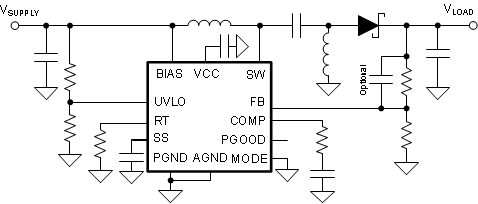SNVSBZ7 October 2021 LM5158 , LM51581
PRODUCTION DATA
- 1 Features
- 2 Applications
- 3 Description
- 4 Revision History
- 5 Description (continued)
- 6 Device Comparison Table
- 7 Pin Configuration and Functions
- 8 Specifications
-
9 Detailed Description
- 9.1 Overview
- 9.2 Functional Block Diagram
- 9.3
Feature Description
- 9.3.1 Line Undervoltage Lockout (EN/UVLO/SYNC Pin)
- 9.3.2 High Voltage VCC Regulator (BIAS, VCC Pin)
- 9.3.3 Soft Start (SS Pin)
- 9.3.4 Switching Frequency (RT Pin)
- 9.3.5 Dual Random Spread Spectrum – DRSS (MODE Pin)
- 9.3.6 Clock Synchronization (EN/UVLO/SYNC Pin)
- 9.3.7 Current Sense and Slope Compensation
- 9.3.8 Current Limit and Minimum On Time
- 9.3.9 Feedback and Error Amplifier (FB, COMP Pin)
- 9.3.10 Power-Good Indicator (PGOOD Pin)
- 9.3.11 Hiccup Mode Overload Protection (MODE Pin)
- 9.3.12 Maximum Duty Cycle Limit and Minimum Input Supply Voltage
- 9.3.13 Internal MOSFET (SW Pin)
- 9.3.14 Overvoltage Protection (OVP)
- 9.3.15 Thermal Shutdown (TSD)
- 9.4 Device Functional Modes
- 10Application and Implementation
- 11Power Supply Recommendations
- 12Layout
- 13Device and Documentation Support
- 14Mechanical, Packaging, and Orderable Information
Package Options
Mechanical Data (Package|Pins)
- RTE|16
Thermal pad, mechanical data (Package|Pins)
- RTE|16
Orderable Information
10.3 System Examples
 Figure 10-3 Typical Boost Application
Figure 10-3 Typical Boost Application Figure 10-4 Typical SEPIC Application
Figure 10-4 Typical SEPIC Application Figure 10-5 LIDAR Bias Supply 1 (DCM Operation)
Figure 10-5 LIDAR Bias Supply 1 (DCM Operation) Figure 10-6 LIDAR Bias Supply 2 (CCM Operation)
Figure 10-6 LIDAR Bias Supply 2 (CCM Operation) Figure 10-7 Low-Cost Single String LED Driver
Figure 10-7 Low-Cost Single String LED Driver Figure 10-8 Secondary-Side Regulated Isolated Flyback
Figure 10-8 Secondary-Side Regulated Isolated Flyback Figure 10-9 Primary-Side Regulated Multiple-Output Isolated Flyback/Isolated SEPIC
Figure 10-9 Primary-Side Regulated Multiple-Output Isolated Flyback/Isolated SEPIC Figure 10-10 Typical Non-Isolated Flyback
Figure 10-10 Typical Non-Isolated Flyback